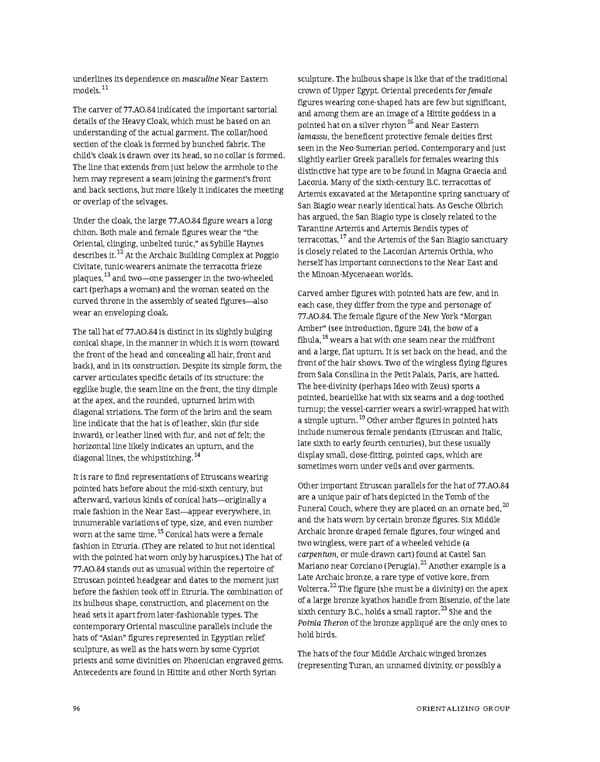underlines its dependence on masculine Near Eastern sculpture. The bulbous shape is like that of the traditional models.11 crown of Upper Egypt. Oriental precedents for female figures wearing cone-shaped hats are few but significant, The carver of 77.AO.84 indicated the important sartorial and among them are an image of a Hittite goddess in a details of the Heavy Cloak, which must be based on an pointed hat on a silver rhyton16 and Near Eastern understanding of the actual garment. The collar/hood lamassu, the beneficent protective female deities first section of the cloak is formed by bunched fabric. The seen in the Neo-Sumerian period. Contemporary and just child’s cloak is drawn over its head, so no collar is formed. slightly earlier Greek parallels for females wearing this The line that extends from just below the armhole to the distinctive hat type are to be found in Magna Graecia and hem may represent a seam joining the garment’s front Laconia. Many of the sixth-century B.C. terracottas of and back sections, but more likely it indicates the meeting Artemis excavated at the Metapontine spring sanctuary of or overlap of the selvages. San Biagio wear nearly identical hats. As Gesche Olbrich Under the cloak, the large 77.AO.84 figure wears a long has argued, the San Biagio type is closely related to the chiton. Both male and female figures wear the “the Tarantine Artemis and Artemis Bendis types of terracottas,17 and the Artemis of the San Biagio sanctuary Oriental, clinging, unbelted tunic,” as Sybille Haynes describes it.12 At the Archaic Building Complex at Poggio is closely related to the Laconian Artemis Orthia, who Civitate, tunic-wearers animate the terracotta frieze herself has important connections to the Near East and plaques,13 and two—one passenger in the two-wheeled the Minoan-Mycenaean worlds. cart (perhaps a woman) and the woman seated on the Carved amber figures with pointed hats are few, and in curved throne in the assembly of seated figures—also each case, they differ from the type and personage of wear an enveloping cloak. 77.AO.84. The female figure of the New York “Morgan The tall hat of 77.AO.84 is distinct in its slightly bulging Amber” (see introduction, figure 24), the bow of a conical shape, in the manner in which it is worn (toward fibula,18 wears a hat with one seam near the midfront the front of the head and concealing all hair, front and and a large, flat upturn. It is set back on the head, and the back), and in its construction. Despite its simple form, the front of the hair shows. Two of the wingless flying figures carver articulates specific details of its structure: the from Sala Consilina in the Petit Palais, Paris, are hatted. egglike bugle, the seam line on the front, the tiny dimple The bee-divinity (perhaps Ideo with Zeus) sports a at the apex, and the rounded, upturned brim with pointed, beanielike hat with six seams and a dog-toothed diagonal striations. The form of the brim and the seam turnup; the vessel-carrier wears a swirl-wrapped hat with line indicate that the hat is of leather, skin (fur side a simple upturn.19 Other amber figures in pointed hats inward), or leather lined with fur, and not of felt; the include numerous female pendants (Etruscan and Italic, horizontal line likely indicates an upturn, and the late sixth to early fourth centuries), but these usually diagonal lines, the whipstitching.14 display small, close-fitting, pointed caps, which are sometimes worn under veils and over garments. It is rare to find representations of Etruscans wearing pointed hats before about the mid-sixth century, but Other important Etruscan parallels for the hat of 77.AO.84 afterward, various kinds of conical hats—originally a are a unique pair of hats depicted in the Tomb of the male fashion in the Near East—appear everywhere, in Funeral Couch, where they are placed on an ornate bed,20 innumerable variations of type, size, and even number and the hats worn by certain bronze figures. Six Middle worn at the same time.15 Conical hats were a female Archaic bronze draped female figures, four winged and fashion in Etruria. (They are related to but not identical two wingless, were part of a wheeled vehicle (a with the pointed hat worn only by haruspices.) The hat of carpentum, or mule-drawn cart) found at Castel San 77.AO.84 stands out as unusual within the repertoire of Mariano near Corciano (Perugia).21 Another example is a Etruscan pointed headgear and dates to the moment just Late Archaic bronze, a rare type of votive kore, from before the fashion took off in Etruria. The combination of Volterra.22 The figure (she must be a divinity) on the apex its bulbous shape, construction, and placement on the of a large bronze kyathos handle from Bisenzio, of the late head sets it apart from later-fashionable types. The sixth century B.C., holds a small raptor.23 She and the contemporary Oriental masculine parallels include the Potnia Theron of the bronze appliqué are the only ones to hats of “Asian” figures represented in Egyptian relief hold birds. sculpture, as well as the hats worn by some Cypriot The hats of the four Middle Archaic winged bronzes priests and some divinities on Phoenician engraved gems. (representing Turan, an unnamed divinity, or possibly a Antecedents are found in Hittite and other North Syrian 96 ORIENTALIZING GROUP
 Ancient Carved Ambers in the J. Paul Getty Museum Page 105 Page 107
Ancient Carved Ambers in the J. Paul Getty Museum Page 105 Page 107